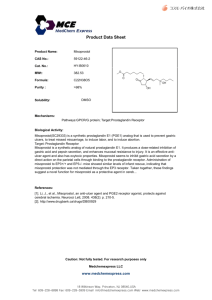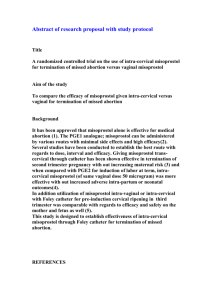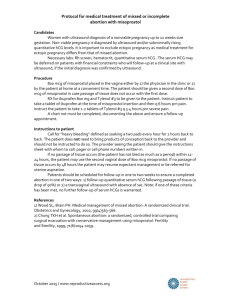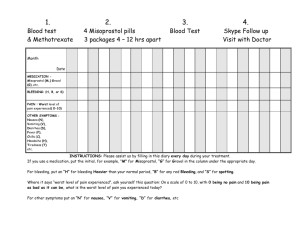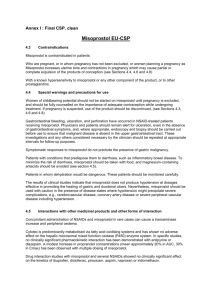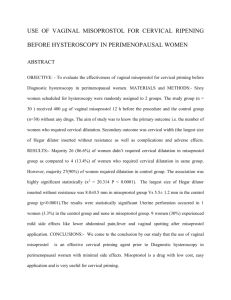Misoprostol
advertisement
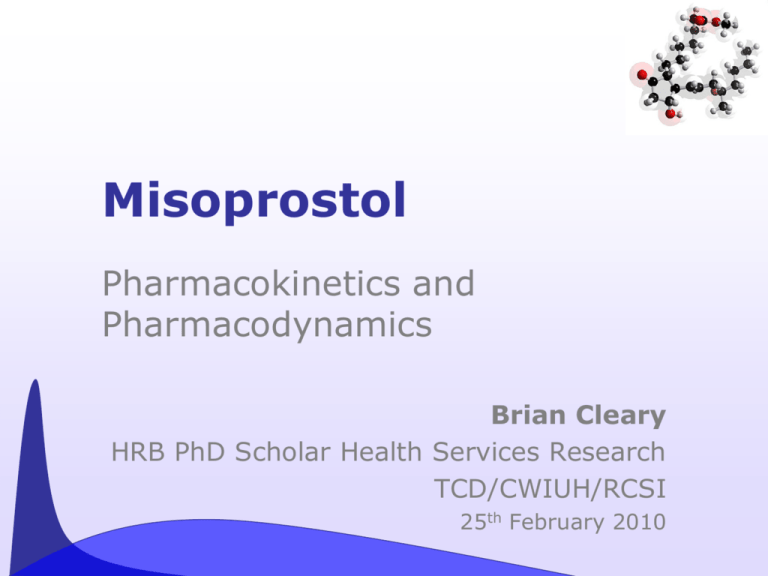
Misoprostol Pharmacokinetics and Pharmacodynamics Brian Cleary HRB PhD Scholar Health Services Research TCD/CWIUH/RCSI 25th February 2010 Overview • Pharmacokinetics – what the body does to the drug • Clinical Implications • Pharmacodynamics – what a drug does to the body • Available products Pharmacokinetics • study of the time course of drug and metabolite concentrations in different fluids, tissues, and excreta of the body, and of the mathematical relationships required to develop models to interpret such data Chemical Structure www.3dchem.com/imagesofmolecules/Misoprostol.jpg Chemistry • discovered in 1973 • prostaglandin E1 analogue • slight structural modifications to: – increase anti-secretory potency – increase duration of action (half life of naturally occurring prostaglandins seconds) – improve oral bioavailability – improve safety profile Absorption • rapidly absorbed after oral doses • peak plasma concentrations occur after about 15 to 30 minutes • food reduces the rate but not the extent of absorption • concomitant antacid use reduces total availability Distribution • high variability of plasma levels between and within studies • mean plasma levels after single oral doses show a linear relationship with dose over the range of 200-400 mcg • no accumulation of misoprostol noted in multiple dose studies • serum protein binding less than 90%, concentration-independent in the therapeutic range Metabolism • undergoes rapid de-esterification to its free acid which is clinically active (misoprostol acid) • misoprostol acid further metabolised by oxidation, primarily in the liver Excretion • mainly urinary excretion- oral administration of radiolabeled misoprostol ~ 80% of detected radioactivity appears in urine • plasma elimination half-life reported to be between 20 and 40 minutes • misoprostol acid is distributed into breast milk • PK studies in patients with varying degrees of renal impairment have shown: – approximate doubling of T1/2, Cmax, and AUC compared to normal controls – no clear correlation between the degree of impairment and AUC. • no routine dosage adjustment recommended in patients with renal impairment, but dosage may need to be reduced if the usual dose is not tolerated • does not affect the hepatic mixed function oxidase (cytochrome P-450) enzyme systems in animals- no known drug interactions Vaginal Administration • longer time to peak plasma conc. (70-80min.) • longer duration of action • greater overall bioavailability (AUC) • large degree of variation in bioavailability between women • mechanism for direct vagina → uterus transport of progesterone exists Sublingual Administration • tablet dissolves in approx. 20 mins. • shorter time to peak conc. than oral and vaginal • highest peak concentration • greatest bioavailability • no first pass metabolism in the liver Pharmacokinetics in Pregnancy Buccal Route • similar concentration profile to vaginal administration • lower bioavailability (~50%) Rectal Route • similar concentration profile to vaginal administration • lower bioavailability (~33%) • onset of action significantly slower than other routes Pharmacokinetics in Pregnancy Clinical Implications REF: misoprostol.org Pharmacodynamics • study of the physiological effects of drugs on the body and the mechanisms of drug action and the relationship between drug concentration and effect Pharmacodynamics • prostaglandins (PGs) induce myometrial contraction in the pregnant and non-pregnant uterus ‘triggers of labour’ • sensitivity of uterine muscle to PGs increases with gestation • PGs lead to cervical ripening and relaxation • naturally occurring PGs rapidly broken down • PGs produced as needed in tissues- not stored • endometrium and myometrium have substantial PG synthesising capacity Pharmacodynamics • role in parturition not fully understood • NSAIDs interfere with cyclo-oxegenase (involved in PG production) and hence prolong labour • EP1 & EP2 receptors contraction promoting, abundant in the fundus • EP3 & EP4 receptors relaxation promoting, found in lower uterine segment • varying expression of receptors may be responsible for differing sensitivity of myometrium throughout gestation and at delivery Pharmacodynamics • regulation of PG receptor expression not extensively studied • progesterone and oestrogen thought to play a role in PG receptor expression • progesterone antagonist mifepristone increases myometrial response to exogenous prostaglandins • thought to up-regulate expression of contraction-promoting PG receptors Physiological Effects Uterotonic • single oral dose ↑ tonus (for 1-2h) • repeated oral doses→regular contractions • single vaginal dose will produce regular contractions (sustained plasma conc.) • increased tonus more rapid and more pronounced with oral/sublingual (8/11 min.) compared with vaginal (20 min.) • differing durations of action Physiological Effects Cervical softening • misoprostol reduces the force required for cervical dilatation • appears to have an action on collagen, encouraging disintegration and dissolution Adverse Effects • • • • • diarrhoea & abdominal pain headache nausea flatulence chills/shivering/fever – Hyperpyrexia (>40°)- doses >600micrograms – Delerium- doses >800micrograms • uterine rupture • uterine hyperstimulation • amniotic fluid embolism case reports Formulations • • • • • • • Cytotec® 200 microgram (oral) tab Isprelor® 25 microgram vaginal tab Gymiso® 200 microgram (oral) tab Prostokos® 25 microgram vaginal tab Vagiprost® 25 microgram vaginal tab Extemp. 1 microgram/ml oral sol. Misopess® Controlled-Release Hydrogel Polymer Vaginal Insert • Licensing issues!! References 1. Aronsson A, Bygdeman M, Gemzell-Danielsson K. Effects of misoprostol on uterine contractility following different routes of administration. Hum. Reprod. 2004;19(1):81-84. 2. Baskett TF. The development of prostaglandins. Best Practice & Research Clinical Obstetrics & Gynaecology 2003;17(5):703706. 3. Bygdeman M. Pharmacokinetics of prostaglandins. Best Practice & Research Clinical Obstetrics & Gynaecology 2003;17(5):707-716. 4. Chong Y-SMM, Su L-LMM, Arulkumaran SFP. Misoprostol: A Quarter Century of Use, Abuse, and Creative Misuse. Obstetrical & Gynecological Survey 2004;59(2):128-140. 5. Cicinelli EM, De Ziegler DM, Bulletti CM, Matteo MGM, Schonauer LMM, Galantino PM. Direct Transport of Progesterone From Vagina to Uterus. Obstetrics & Gynecology 2000;95(3):403-406. 6. Danielsson KG, Marions L, Rodriguez A, Spur BW, Wong PYK, Bygdeman M. Comparison between oral and vaginal administration of misoprostol on uterine contractility. Obstetrics & Gynecology 1999;93(2):275. 7. Khan R-UM, El-Refaey HMDM, Sharma SM, Sooranna DP, Stafford MMDM. Oral, Rectal, and Vaginal Pharmacokinetics of Misoprostol. Obstetrics & Gynecology 2004;103(5, Part 1):866-870. 8. Meckstroth KRMDMPH, Whitaker AKMD, Bertisch SMD, Goldberg ABMDMPH, Darney PDMDM. Misoprostol Administered by Epithelial Routes: Drug Absorption and Uterine Response. Obstetrics & Gynecology 2006;108(3, Part 1):582-590. 9. Norman JE, Thong KJ, Baird DT. Uterine Contractility and Induction of Abortion in Early Pregnancy by Misoprostol and Mifepristone. Obstetrical & Gynecological Survey 1992;47(4):282. 10. Olson DM. The role of prostaglandins in the initiation of parturition. Best Practice & Research Clinical Obstetrics & Gynaecology 2003;17(5):717-730. 11. Rayburn WF, Powers BL, Plasse TF, Carr D, Di Spirito M. Pharmacokinetics of a Controlled-Release Misoprostol Vaginal Insert at Term. Journal of the Society for Gynecologic Investigation 2006;13(2):112-117. 12. Spitz IM, Bardin CW. Mifepristone (RU 486) -- A Modulator of Progestin and Glucocorticoid Action. N Engl J Med 1993;329(6):404-412. 13. Tang OS, Schweer H, Seyberth HW, Lee SWH, Ho PC. Pharmacokinetics of different routes of administration of misoprostol. Hum. Reprod. 2002;17(2):332-336. 14. Tang OS, Gemzell-Danielsson K, Ho PC. Misoprostol: pharmacokinetic profiles, effects on the uterus and side-effects. Int J Gynaecol Obstet 2007;99 Suppl 2:S160-7. Thank You!
